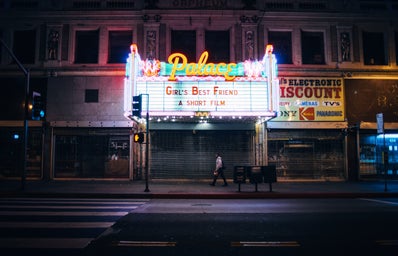It’s interesting how, in the modern-day age of action-packed CGI cinema, a movie in black and white with a relatively simple plot has managed to earn an impressive 10 Oscar nominations. It’s tied for the most-nominated film with The Favourite, and it’s even nominated for Best Picture next to Black Panther, another film lauded for its positive representations of PoC. That being said, Roma is making waves for a very important reason. Well, several, but we’ll get to that in a moment. Warning, spoilers ahead.
Roma is a visual landscape of grayscale pleasures. It’s amazing how a movie that’s devoid of color manages to paint such a vivid, believable experience. There is more than meets the surface to this choice in coloring—or lack thereof. The stylistic choice may or may not be symbolic of the bleak feeling of imminent monotony and routine that the protagonist, Cleo, is practically forced to endure in class-divided Mexico. Whatever the reason, it helps the viewer focus on all the other sensations and sounds that the movie evokes.
The movie portrays Latin representations that are stripped of stereotypical melodrama (like telenovelas) and a general humanization of tired tropes (such as the unattractive, middle-aged, non-sexually active housemaid who serves a middle-class family out of empathy). Roma represents Latinxs in a more realistic way than most movies would dare to do. The characters feel like real people and not caricatures of what people think Latinxs should be.
Mundane actions are represented through Cuarón’s extremely detailed long takes, plus all the sounds (think of the songs on the radio that spontaneously pop up throughout the movie), and sights (the aesthetics are on point; class inequality is noticeable even in the clothing) really make for a visual feast. It’s like the director filmed fake scenes for a documentary without realizing it. Or, he was that keen on making everything simultaneously gorgeous and believable. Either way, it’s bound to win Best Cinematography at the Oscars.
Roma illustrates why the conversation surrounding the intersectional should still be relevant: women of mixteco heritage (and of other native ethnic identities) were forced to take up jobs serving middle-class families that were mostly comprised of light-skinned Mexicans or gringos (a term that the movie wisely employed). There is a marked distinction between the upper-class struggle versus the lower class daily realities: while Sofía was struggling to keep her family of six plus two servants together, Cleo didn’t have a choice concerning over her own body or lifestyle. She had to give birth to a baby she didn’t even want to have and received no sort of support during her pregnancy from the man who got her pregnant. In fact, he even threatened to attack her if she approached him again. Sofía likely received support during her pregnancy, but Cleo didn’t even know she was carrying a child until she was three month in.
The struggles these two women face are vastly different, and while Sofía could be considered in some ways as free as her husband, Cleo was trapped even if her work was deemed voluntary. Even if she did love Sofía´s children, Cleo (and all the other women cleverly sprinkled throughout different long takes in the movie) have to accept what is given to them without much thought. The conquest and overtaking of the land where Cleo´s mother lived and the way Teresa reacts when the nurse asks about Cleo in the reception desk is proof enough of how horrible Cleo´s situation is. This theme of lack of control, sorrow, and solitude reaches its peak with Cleo´s miscarriage. It’s a tear-jerking moment that makes you want to rip heads off. The themes more than make up for a somewhat (apparently) uneventful storyline and a win for Best Picture would be both parts unprecedented and celebrated.
The cinematography blends in perfectly with the acting. Nothing is overacted, flashy, or too outlandish. Everything makes sense in this universe, and the actors managed to capture recognizable archetypes in Latin culture without making them seem like caricatures. The fact that the actors were actually Latin and possibly grew up surrounded by the characters they portrayed probably helped place the set into an almost time-capsule state. There were genuine character studies and cultural backgrounds (courtesy of the director and probably part if not most of the cast) in check that led the entire narrative in a tasteful and honest direction.
Yalitza Aparicio made me cry, wonder, lash out in frustration, and smile over the believability and strength of her character. Even without over-the-top risks and climactic plot points, I was genuinely moved by her and keep feeling she deserved better, even if she did end up considering her employer’s family as an extension of her own family. She really did deserve to have her own child, husband, and own home, even if she didn’t want it.
The horror in Roma, to my taste, is the fact that she probably might not ever be able to have her own life the way Sofía does with four healthy children, a modest sized home in the middle of the city, the ability to switch easily between well-payed professions, the time to worry about her own health, and something that many women take for granted, the ability to have agency over your life conditions. Even if Cleo is actually treated like a family member, in the long run, she barely has a choice. The rest of the world has already been too cruel towards her for her to consider turning back. Aparicio brings this character to life as if she’s seen the script a million times, and it’s amazing.
If you haven’t seen Alfonso Cuarón´s Roma, head over to Netflix, and give it a spin. Many people describe it as slow or even boring, but you have to notice the fine details hidden in the dialogue and the other characters to see the stories going on right behind the main scenes.
This movie is up for 10 Academy Awards. The nominations are:
-
Best Picture for Gabriela Rodríguez and Alfonso Cuarón
-
Best Director for Alfonso Cuarón
-
Best Actress for Yalitza Aparicio
-
Best Supporting Actress for Marina de Tavira
-
Best Original Screenplay for Alfonso Cuarón
-
Best Foreign Language Film
-
Best Cinematography for Alfonso Cuarón
-
Best Production Design for Eugenio Caballero and Bárbara Enríquez
-
Best Sound Editing for Sergio Díaz and Skip Lievsay
-
Best Sound Mixing
Roma´s a shoo-in for Best Director, Best Foreign Language Film, Best Cinematography, and Best Sound Editing. It faces tough competition in other categories, but it really excelled in creating an immersive, realistic experience like no other.
The 2019 Oscars Ceremony will take place on February 24th, 2019. Make sure to tune in to see if Roma turns it out!


